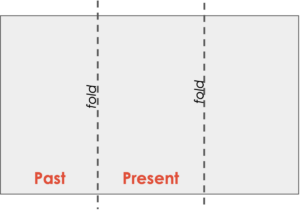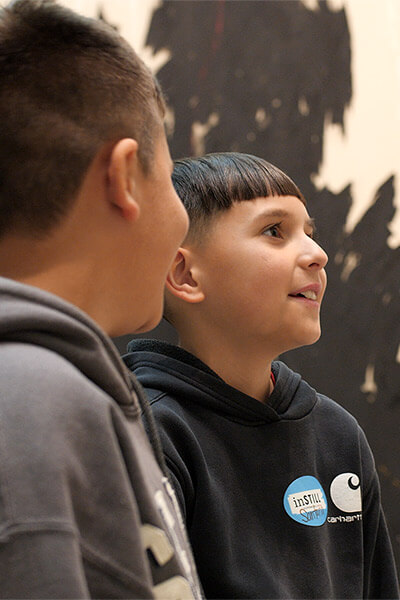By Allyson Johnson and Emily Townsend, Clyfford Still Museum educators
Summary:
The purpose of this activity is to think about how our individual experiences shape our identity. Students will engage in art-looking, art-making and reflection during this lesson. Students will explore where they have come from, what they have experienced and where they might like to be in the future in order to more deeply understand the concept of change. This lesson is a great way to introduce or explore the concept of a growth mindset with your students.
Big Idea:
- I am always learning about myself and others.
Essential Questions:
- How does learning shift over time?
- Who am I?
Learning Targets:
- My ideas are important, I can share them with others.
- I can reflect on my identity and my experiences.
Time:
- 45 – 60 minutes
Materials:
- Paper
- Drawing Supplies
- Past, Present, Future Slides
Standards:
Colorado Visual Arts Standards:
- Standard 4: Relate and Connect to Transfer
Colorado Prepared Graduates in Visual Arts:
1. See oneself as a participant in visual art and design by experiencing, viewing or making.
10. Develop new knowledge by actively doing and making (artistic praxis), acknowledging relationships between materials, objects, ideas and lived experience.
National Visual Arts Standards:
- Creating Anchor Standard 1:
- Generate and conceptualize artistic ideas and work (applies to all grade levels)
- Responding Anchor Standard 8:
- Interpret intent and meaning in artistic work (applies to all grade levels)
- Connecting Anchor Standard 11:
- Synthesize and relate knowledge and personal experiences to make art (applies to all grade levels)
CASEL SEL Framework:
- SELF-AWARENESS: The abilities to understand one’s own emotions, thoughts, and values and how they influence behavior across contexts.
Steps:
1. Mindfulness (3 minutes)
- Invite students to reflect on the idea of change. What does it mean to you?
- What changes have you experienced today, this week, in life?
2. Art Looking (10 minutes)
- Project a page of CS’s paintings via the Online Collection. (Ensure you have a mix of realistic and abstract art).
- Invite students to share what they notice about the art. Confirm all responses and ask for evidence in their observations.
- If no one brings up the difference between realistic, transitional and abstract, do so. Share with students that CS changed his style of art over time, as his life changed.
- With older students this is an opportunity to bring in a conversation about context, the Great Depression and WWII.
- Share the idea of organizing CS’s work according to its dates to show his “life” or “timeline”. (Organize the paintings in this way, if time allows.)
- This is an opportunity to introduce sequence language (First, Next, Then, Last) and/or ordinal numbers.
- For younger students, it may be helpful to remove the ‘19’ from the dates to make them more manageable.
- Invite students to turn and talk with a partner about what they notice once the paintings are organized in chronological order.
3. Art-Making (20 minutes)
- Distribute 8×11 (or larger) paper. Fold paper in thirds or draw two lines that separate the paper into three even parts or boxes.
- Share the labels for each section, ‘past’, ‘present’ and ‘future’.
- Invite students to consider past experiences, recalling events from earlier in the year or previous years. Possible prompts include:
- How was the past similar or different?
- Have you changed over time? How? Why?
- Invite students to consider past experiences, recalling events from earlier in the year or previous years. Possible prompts include:
- Invite students to sketch the ‘past’ in the first box. This could be a specific moment, a stretch of time, whatever ‘past’ means to each student.
- Invite students to try to capture their feelings of the past by using colors, lines, shapes, and textures, instead of a story or a scene from the past.
- In the second box, invite students to sketch about the ‘present’.
- The same directions apply here, encourage students to express how they feel in the present with lines, shapes and textures.
- In the final box, invite students to sketch about the ‘future.’
- Encourage students to draw a feeling or idea.
- As students sketch, rotate and ask questions about their work, focus on the process.
- Possible questions:
- Can you share more about that idea?
- What made you think of _____ or decide _____?
- If you had more time/different materials, would your ideas be different? How?
- What do you think you will do next?
- Possible questions:
4. Reflection (7 minutes)
- Share that we all experience change in our lives. Here we have split our life experience into 3 parts, but there are many more changes in our lives.
- Discuss the concept of change through turn and talk or movement or both.
- Students can play a game like Inside Outside Circle to talk with a new partner about each question.
- Instead of talking, students can show the answers to the questions with their bodies, then explain to a partner or the whole group, if desired.
- Possible prompts include:
- How do you feel when a change happens?
- How do you feel when you are expecting a change?
- How do you feel when you aren’t expecting a change?
- I feel… (add emoji on a slide)
- When _____, I feel…
- Why do you think people have different reactions to change?
- How can we help each other prepare for changes in our classroom?
- I think…
- In my opinion,…
- I agree/disagree…
Examples:
 |
 |
Differentiation:
Content:
- Model and provide examples
- Give verbal descriptions of the artwork
- Use Individual reproductions of artwork to allow for close viewing
Process:
- Confer with and support students during work-time
- Allow for student voice and choice in all parts of the lesson
- Facilitate VTS individually, in small groups, or whole class
- Allow students to write or draw while processing/listening
- Provide sentence stems and sentence frames
- Use non-verbal participation techniques (like thumbs up/thumbs down)
Environment:
- Allow for a quiet space or breaks for students as needed
- Allow students to regulate using headphones if appropriate

